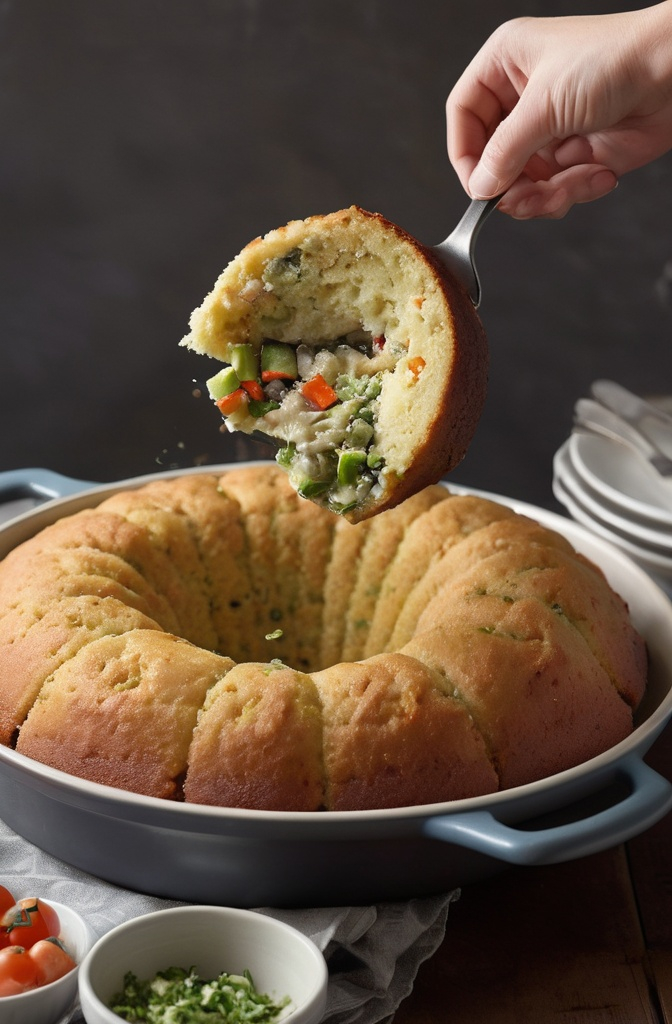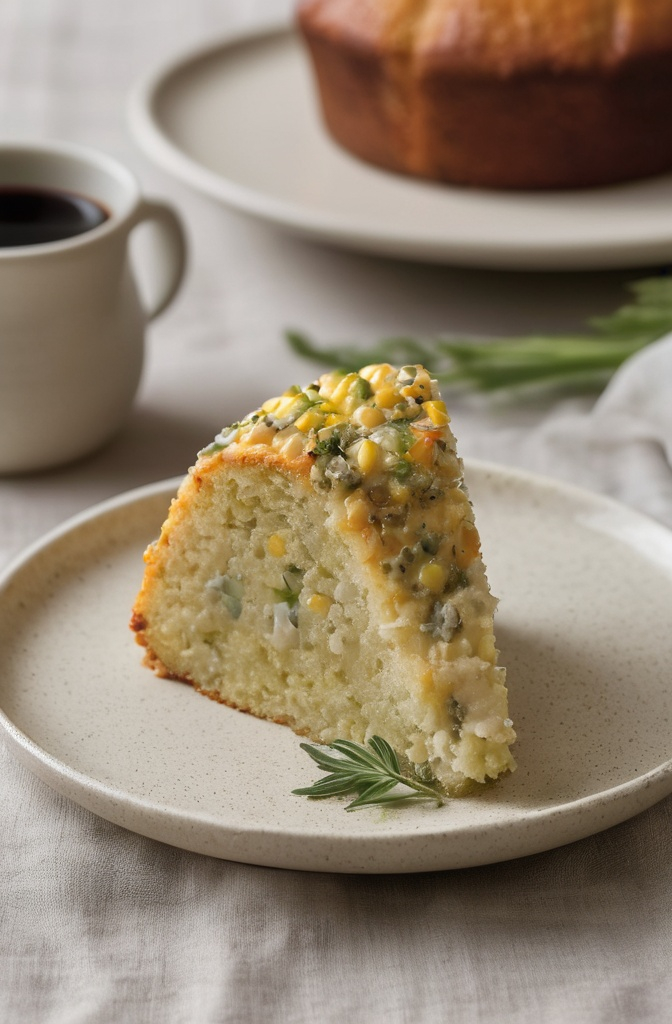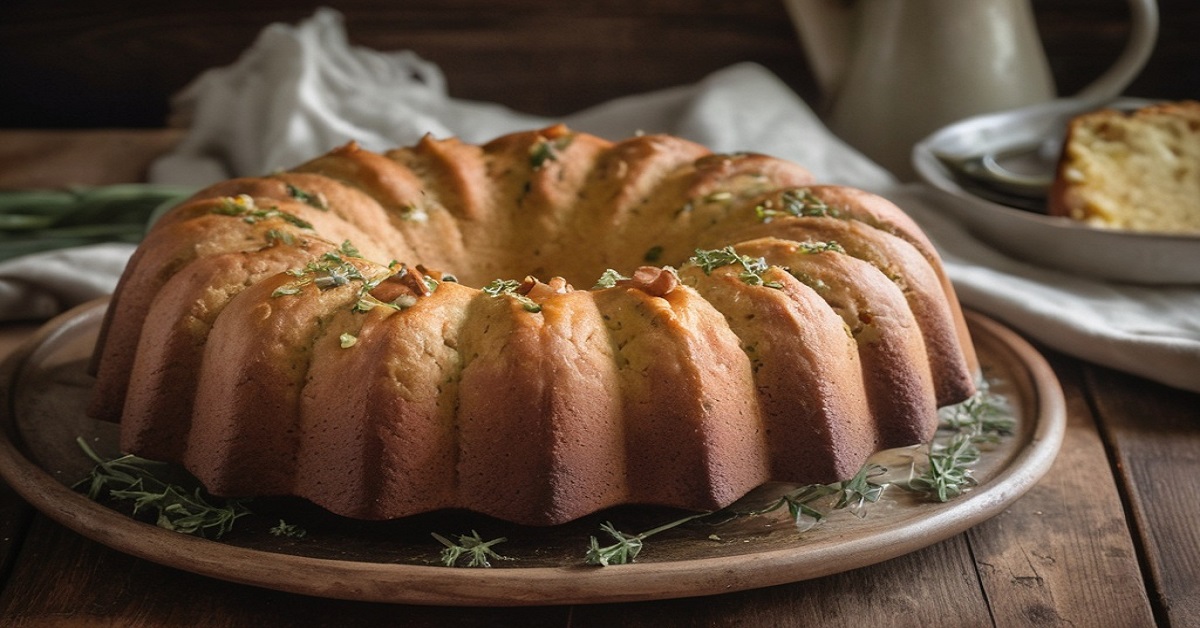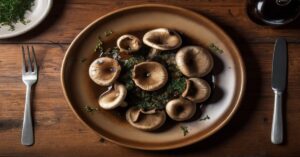Bundt Pan Corn Bread Dressing Recipe: I’ll tell you what, there’s something strangely comforting about the way old cast iron smells when it’s just barely cooled off. My grandma used to bake her cornbread in a skillet that was older than any of us, swore it gave the dressing “soul.”
I didn’t quite understand what she meant ‘til I tried baking mine in a Bundt pan for the first time. Now? I won’t do it any other way.
Cornbread dressing this is not stuffing, let’s get that straight is the backbone of Southern holiday tables. It’s rich, it’s savory, a little messy, a lot emotional. And baking it in a Bundt pan? Well, now you’ve got yourself something that looks as good as it tastes. You get that golden crust all the way around, not just the top. It’s crisp where you want it, steamy-soft where you don’t.
But it ain’t just about the looks. The ring shape holds heat evenly and gives you more of those crispy edge bits everyone fights over. We’re taking an old-school recipe and dressing it up (pun obviously intended).
Let’s get to it.
What Is Bundt Pan Corn Bread Dressing and Why It Matters

This is your classic Southern cornbread dressing, but baked in a Bundt pan for a dramatic, almost cake-like presentation. But it’s no gimmick. The pan changes how the dressing bakes creating crispness all over and holding moisture in the middle.
We’re still using deeply savory ingredients: house-made cornbread, sautéed aromatics, rich chicken stock, eggs for binding, and of course, a generous hand with the sage. It’s humble, sure. But when made right, it’s complex in flavor earthy, toasty, herbaceous, and deeply satisfying.
Alright, let’s build the bones first.
Ingredients & Substitutions
Here’s what you’ll need, but don’t be afraid to make it your own. This dish is as much about memory as it is about technique.
Cornbread Base
- 3 cups crumbled day-old cornbread (homemade if you can swing it)
- 2 cups toasted white bread, cubed small
- 1/2 cup unsalted butter, melted
Substitute tip: Gluten-free bread? Absolutely. Just toast it well so it doesn’t turn mushy. And if you’re low on cornbread, swap in more toasted bread—but know you’ll lose a bit of that sweet, gritty backbone.
Aromatics & Flavor
- 1 medium yellow onion, finely chopped
- 3 ribs celery, finely chopped
- 1 large carrot, grated (for a hint of sweetness)
- 2 cloves garlic, minced
- 1/4 cup fresh parsley, chopped
- 1 tbsp fresh sage, minced (or 1 tsp dried)
- 1 tsp thyme leaves, fresh or dried
- 1/2 tsp black pepper
- 1 tsp kosher salt, or more to taste
Why fresh herbs? They lift the dish, make it sing. Dried can work in a pinch, but you’ll miss the brightness.
Liquids & Binding
- 2 large eggs, beaten
- 1 1/2 to 2 cups chicken or turkey stock, warm
- Optional: 1/2 cup whole milk or heavy cream for added richness
Vegetarian? Use mushroom broth for an umami bomb. Add sautéed mushrooms too if you’re feelin’ it.
Optional Add-Ins
- 1/2 cup crumbled sausage, cooked (and drained well)
- 1/2 cup chopped pecans (adds texture)
- 1/2 tsp cayenne or hot sauce, if you like it feisty
Step-by-Step Instructions
1. Make Your Cornbread (the day before)
Bake it plain no sugar, no cheese, no jalapeños. Just cornmeal, flour, eggs, buttermilk, and a bit of oil. Let it sit overnight. You want it to dry out a little. Trust me it soaks up flavor better that way.
2. Toast Your White Bread
Cube it, spread it out, toss in the oven at 300°F for 15 minutes. You want it dry but not burnt. Like crouton territory.
3. Sauté Your Veggies
In a big ol’ skillet, melt butter over medium heat. Add onions, celery, carrot. Cook ‘em low and slow till everything’s soft and a little golden about 10 mins. Add garlic last, so it doesn’t burn. Throw in herbs at the end, just to wake them up with the heat.
4. Mix the Base
In a massive bowl, combine the cornbread, bread cubes, and sautéed veg. Add salt, pepper, and whatever extras you’re using. Stir it gently don’t smash it.
5. Add Liquids
Pour in the eggs and stock slowly. You want the mix damp, not soupy. Add cream if you like it decadent. Let it sit 10 minutes so everything marries together.
Tip: Grab a scoop with your hand. If it holds its shape but feels soft, you nailed it.
6. Grease Your Bundt Pan Like It Owes You Money
Use butter, and don’t be stingy. Get into every crevice. You want that dressing to pop out clean like a sandcastle.
7. Pack It In
Spoon the mixture into the pan, pressing down gently. Not too tight or it’ll get gummy. Bake at 375°F for 40–50 minutes, till it’s golden and pulling away from the edges.
8. Cool Slightly, Then Flip
Let it rest 10–15 minutes before inverting onto a platter. Don’t rush it or it’ll crack. If it sticks, loosen gently with a rubber spatula.
Cooking Techniques & Why They Matter
Why the Bundt pan?
It’s not just for aesthetics. The hole in the middle helps heat penetrate evenly, so you get moist dressing without that tragic soggy core. And the curved walls encourage more crisp edges everyone wins.
Why sauté first?
Raw onions and celery in dressing is a rookie mistake. Sautéing mellows their bite and draws out their sweetness. You want savory depth, not raw salad crunch.
Eggs and stock ratio?
That’s the trickiest part. Too much liquid? You’ve got mush. Too little? It’s dry like old cornbread on the windowsill. Add slowly, test often.
Butter vs. oil?
Butter all the way for flavor. It adds richness and helps everything brown. But if you’re dairy-free, go for avocado oil clean taste, high smoke point.
Serving & Pairing Suggestions

How to Serve It
Flip it out onto a white platter. Garnish with fresh thyme or parsley. Serve it in slices like cake it’s the holidays, be a little dramatic.
Perfect Pairings
- Roast turkey with citrus glaze
- Braised greens with vinegar and chili flakes
- Cranberry-orange relish for contrast
- A glass of oaked chardonnay or cold hard cider
This dressing can hold its own, though. It’s not a side, it’s a statement.
FAQs About Bundt Pan Corn Bread Dressing Recipe
1. Can I make this dressing ahead of time?
Yes. Assemble everything and refrigerate overnight. Bake it day-of. It actually tastes better when the flavors have time to meld.
2. My dressing came out too wet. What went wrong?
You likely added too much stock. Next time, go slow mix and test as you go. Also, make sure your cornbread and bread cubes are dry enough to absorb liquid properly.
3. How do I get it to release cleanly from the Bundt pan?
Grease generously with butter and let it rest before flipping. If it’s still stuck, gently run a rubber spatula along the sides to loosen.
4. Can I freeze this dressing?
Sure can. Wrap slices individually, freeze up to 2 months. Reheat in the oven for best texture microwave makes it soggy.
5. What if I don’t have a Bundt pan?
You can use a well-greased springform or loaf pan, but you’ll lose some of that crusty magic. Bundt is worth it if you can get one.
Want more Southern classics with a twist? I’ve got a skillet of secrets just waitin’ to be spilled. Would you like a printable version of this recipe or a visual step-by-step guide?
Final Thoughts: What Makes This Dressing So Darn Special
It’s rustic, familiar, but also kinda refined. Baking in the Bundt pan gives it form, texture, and style. You get that nostalgic flavor with just enough elevation to make folks ask how you did it.
This isn’t a “throw it in the pan and hope” kind of dish. Every step has intention. And when you nail it? It’s not just a side dish it’s the thing people remember.
Pro Tip: Got leftovers? Slice and pan-fry in a little butter till crispy. Top with a fried egg and hot sauce. Breakfast, sorted.




